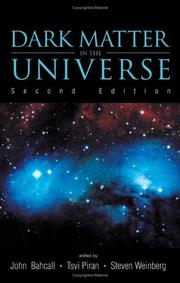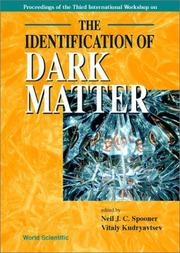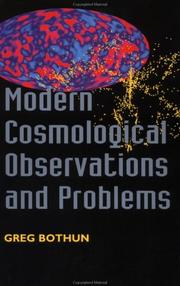| Listing 1 - 10 of 166 | << page >> |
Sort by
|
Book
ISBN: 0716721570 Year: 1991 Publisher: New York, NY : W. H. Freeman,
Abstract | Keywords | Export | Availability | Bookmark
 Loading...
Loading...Choose an application
- Reference Manager
- EndNote
- RefWorks (Direct export to RefWorks)
Cosmology. --- Dark matter (Astronomy) --- Dark matter (Astronomy). --- Dark matter (astronomy)
Book
ISBN: 9780192861597 019286159X Year: 1993 Publisher: Oxford Oxford University Press
Abstract | Keywords | Export | Availability | Bookmark
 Loading...
Loading...Choose an application
- Reference Manager
- EndNote
- RefWorks (Direct export to RefWorks)

ISBN: 1281880701 9786611880705 9812567186 9789812567185 9812388400 9789812388407 9812388419 9789812388414 Year: 2004 Publisher: New Jersey ; London : World Scientific,
Abstract | Keywords | Export | Availability | Bookmark
 Loading...
Loading...Choose an application
- Reference Manager
- EndNote
- RefWorks (Direct export to RefWorks)
If standard gravitational theory is correct, then most of the matter in the universe is in an unidentified form which does not emit enough light to have been detected by current instrumentation. This book is the second edition of the lectures given at the 4th Jerusalem Winter School for Theoretical Physics, with new material added. The lectures are devoted to the ""missing matter"" problem in the universe, the search to understand dark matter. The goal of this volume is to make current research work on unseen matter accessible to students without prior experience in this area and to provide insights

ISBN: 9812811362 9789812811363 9789810246020 9810246021 Year: 2001 Publisher: Singapore River Edge, N.J. World Scientific
Abstract | Keywords | Export | Availability | Bookmark
 Loading...
Loading...Choose an application
- Reference Manager
- EndNote
- RefWorks (Direct export to RefWorks)
The objective of the workshop series "The Identification of Dark Matter" is to assess critically the status of work attempting to identify what constitutes dark matter; in particular, to consider what techniques are currently being used, how successful they are, and what new techniques are likely to improve the prospects for identifying dark matter candidates in the future. This proceedings volume includes reviews on major particle astrophysics topics in the field of dark matter, as well as short contributed papers.
Book
Year: 2022 Publisher: London, United Kingdom : IntechOpen,
Abstract | Keywords | Export | Availability | Bookmark
 Loading...
Loading...Choose an application
- Reference Manager
- EndNote
- RefWorks (Direct export to RefWorks)
This book presents several new, important explanations for dark matter, all dissimilar to the discredited subatomic particle-like but invisible matter. One chapter presents evidence that abundant cold hydrogen, baryonic matter, is the source of the missing gravity. Another chapter suggests that dark matter is better explained by stars in spiral galaxies that follow non-Keplerian orbits. A third chapter proposes that gravity attributed to dark matter is due to the sprinkling of black holes throughout galaxies, which is supported by LIGO/Virgo observations. Another chapter questions the assumptions of the Friedmann (FLRW) model, proposing a better method for handling astrophysical data. Additional chapters discuss cosmic ray propagation, axion decay, the cosmological scale factor, and the philosophical outlook of cosmologists when dealing with the questions of dark matter and dark energy.

ISBN: 0748403329 Year: 1998 Publisher: London : Taylor and Francis,
Abstract | Keywords | Export | Availability | Bookmark
 Loading...
Loading...Choose an application
- Reference Manager
- EndNote
- RefWorks (Direct export to RefWorks)
Book
Year: 2022 Publisher: London, United Kingdom : IntechOpen,
Abstract | Keywords | Export | Availability | Bookmark
 Loading...
Loading...Choose an application
- Reference Manager
- EndNote
- RefWorks (Direct export to RefWorks)
This book presents several new, important explanations for dark matter, all dissimilar to the discredited subatomic particle-like but invisible matter. One chapter presents evidence that abundant cold hydrogen, baryonic matter, is the source of the missing gravity. Another chapter suggests that dark matter is better explained by stars in spiral galaxies that follow non-Keplerian orbits. A third chapter proposes that gravity attributed to dark matter is due to the sprinkling of black holes throughout galaxies, which is supported by LIGO/Virgo observations. Another chapter questions the assumptions of the Friedmann (FLRW) model, proposing a better method for handling astrophysical data. Additional chapters discuss cosmic ray propagation, axion decay, the cosmological scale factor, and the philosophical outlook of cosmologists when dealing with the questions of dark matter and dark energy.
Book
ISBN: 0813565324 Year: 2014 Publisher: New Brunswick, New Jersey : Rutgers University Press,
Abstract | Keywords | Export | Availability | Bookmark
 Loading...
Loading...Choose an application
- Reference Manager
- EndNote
- RefWorks (Direct export to RefWorks)
What's in the dark? Countless generations have gazed up at the night sky and asked this question-the same question that cosmologists ask themselves as they study the universe. The answer turns out to be surprising and rich. The space between stars is filled with an exotic substance called "dark matter" that exerts gravity but does not emit, absorb, or reflect light. The space between galaxies is rife with "dark energy" that creates a sort of cosmic antigravity causing the expansion of the universe to accelerate. Together, dark matter and dark energy account for 95 percent of the content of the universe. News reporters and science journalists routinely talk about these findings using terms that they assume we have a working knowledge of, but do you really understand how astronomers arrive at their findings or what it all means? Cosmologists face a conundrum: how can we study substances we cannot see, let alone manipulate? A powerful approach is to observe objects whose motion is influenced by gravity. Einstein predicted that gravity can act like a lens to bend light. Today we see hundreds of cases of this-instances where the gravity of a distant galaxy distorts our view of a more distant object, creating multiple images or spectacular arcs on the sky. Gravitational lensing is now a key part of the international quest to understand the invisible substance that surrounds us, penetrates us, and binds the universe together. A Ray of Light in a Sea of Dark Matter offers readers a concise, accessible explanation of how astronomers probe dark matter. Readers quickly gain an understanding of what might be out there, how scientists arrive at their findings, and why this research is important to us. Engaging and insightful, Charles Keeton gives everyone an opportunity to be an active learner and listener in our ever-expanding universe. Watch a video with Charles Keeton: Watch video now. (http://www.youtube.com/watch?v=Uc3byXNS1G0).
Book
ISBN: 1281897418 9786611897413 9812701842 9789812701848 9781281897411 6611897410 Year: 2005 Publisher: Singapore ; River Edge, NJ : World Scientific,
Abstract | Keywords | Export | Availability | Bookmark
 Loading...
Loading...Choose an application
- Reference Manager
- EndNote
- RefWorks (Direct export to RefWorks)
The prestigious Identification of Dark Matter workshop series was initiated to assess the status of work that attempts to identify the constitution of dark matter. In particular, it aims to review the success of current methods that are used in the search for dark matter, as well as the new techniques that are likely to improve prospects for detecting possible dark matter candidates in the future. In the 5th International Workshop, special emphasis was placed on the recent results obtained in experiments searching for baryonic and non-baryonic dark matter. This volume comprises the high-qualit
Book
ISBN: 1613246226 9781613246221 9781608764730 1608764737 Year: 2010 Publisher: New York Nova Science Publishers
Abstract | Keywords | Export | Availability | Bookmark
 Loading...
Loading...Choose an application
- Reference Manager
- EndNote
- RefWorks (Direct export to RefWorks)
| Listing 1 - 10 of 166 | << page >> |
Sort by
|

 Search
Search Feedback
Feedback About
About Help
Help News
News